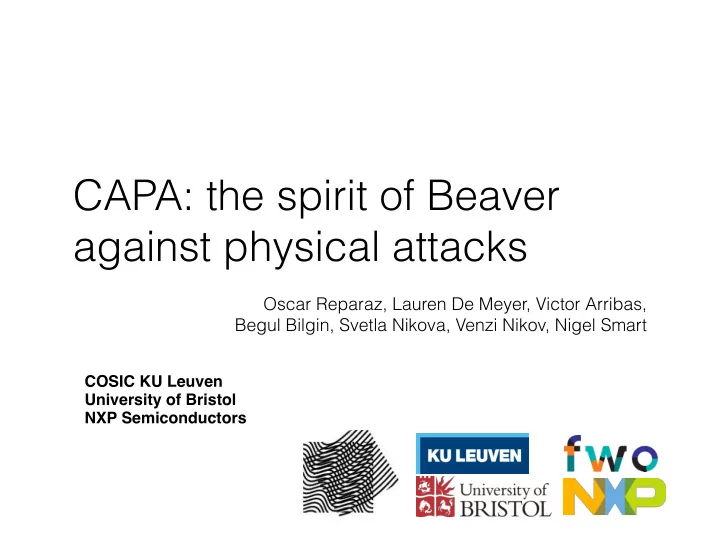

CAPA: the spirit of Beaver against physical attacks Oscar Reparaz, Lauren De Meyer, Victor Arribas, Begul Bilgin, Svetla Nikova, Venzi Nikov, Nigel Smart COSIC KU Leuven University of Bristol NXP Semiconductors
Problem statement 2
(Johann Heyszl)
Problem statement • Implementation of crypto in a hostile environment • This paper : adapt MPC protocols to run in hardware 4
FHE? SPDZ BODZ countermeasures for MASCOT physical attacks Tiny-OT Masking + duplication MPC Masking / ISW Balanced logic Duplication in time / space Circuit meshes randomized circuit layout Light / glitch detectors In-circuit noise generators
FHE? SPDZ BODZ countermeasures for MASCOT physical attacks Tiny-OT Masking + duplication MPC Masking / ISW Balanced logic Duplication in time / space Circuit meshes randomized circuit layout Light / glitch detectors In-circuit noise generators
FHE? SPDZ BODZ countermeasures for MASCOT physical attacks Tiny-OT Masking + duplication MPC Masking / ISW Balanced logic Duplication in time / space Circuit meshes randomized circuit layout Light / glitch detectors In-circuit noise generators
Adversarial model: tile fault-and-probe Tile IV Tile I Tile III Tile II ≈ Tile party 8
Adversarial model: tile fault-and-probe Tile IV Tile I Tile III Tile II Adversarially controlled ≈ Tile party 9
Adversarial model: SCA • Adversary is allowed to probe all intermediates within a set of tiles (all except one). Values are disclosed with probability 1 • Related to the noisy leakage model 10
Adversarial model: FA A. known value fault in any intermediate within up to ≈ (d-1)-tiles • powerful, inherited by SPDZ B. random fault everywhere • very relevant for HW • There is fine print: static adversary. notion of time: computation periods 11
Adversarial model: FA A. known value fault in any intermediate within up to ≈ (d-1)-tiles • powerful, inherited by SPDZ B. random fault everywhere ≈ • very relevant for HW • There is fine print: static adversary. notion of time: computation periods (J-M Schmidt, M. Hutter) 12
Current countermeasures • Orthogonal topics: side-channel protection + fault protection • A few combined attacks (more difficult) 15
Different worlds - analogies and differences Party Tile in the silicon expensive communication channel wires on the circuit local memory cheap reduced storage adversary controls arbitrarily some parties, adversary external, controls somehow some parties, DFA mostly can plot arbitrary attacks (bit flips, set, clear)
CAPA • How to represent data • How to perform computation 17
CAPA: data representation Main idea: attach an info-theoretical MAC to each piece of data • Handle (shares of data, shares of MAC tag) • shares of data = Boolean shares of data • MAC tag: multiplicative tag • shares of MAC tag: Boolean shares of the tag 18
CAPA: data representation Main idea: attach an info-theoretical MAC to each piece of data • Handle (shares of data, shares of MAC tag) • shares of data = additive secret sharing • MAC tag: multiplicative tag • shares of MAC tag: Boolean shares of the tag 19
CAPA: data representation Main idea: attach an info-theoretical MAC to each piece of data • Handle (shares of data, shares of MAC tag) • shares of data = additive shares of data • MAC tag: multiplicative tag • shares of MAC tag: Boolean shares of the tag 20
CAPA: data representation Main idea: attach an info-theoretical MAC to each piece of data • Handle (shares of data, shares of MAC tag) • shares of data = additive shares of data • MAC tag: multiplicative tag • shares of MAC tag: additive shares of the tag 21
CAPA: computation • Linear operations are easy • Multiplication A. Blinding B. Partial unmasking C. MAC tag checking D. Beaver step 22
CAPA: computation • Linear operations are easy Inputs • Multiplication Auxiliary data A. Blinding B. Partial unmasking C. MAC tag checking D. Beaver step 23
CAPA: computation eps1 t A. Blinding tile 1 eps2 t eps3 t tile 2 tile 3 24
CAPA: computation eps1 t B. Partial unmasking eps Broadcast shares of tile 1 eps to unmask the value eps2 t eps3 t eps eps tile 2 tile 3 each broadcasting needs a synchronization element 25
CAPA: computation eps1 t C. MAC tag checking eps t Are partially unmasked values tile 1 consistent with their tags? broadcast verify is zero eps2 t eps3 t eps t eps t tile 2 tile 3 26
CAPA: computation z1 t D. Beaver computation The actual tile 1 multiplication (local) z2 t z3 t tile 2 tile 3 27
CAPA: PRE computation • Auxiliary data needed for multiplication • Generate using a passively secure multiplier • Relation verification step 28
Security guarantees • Side-channels: the union of d-1 tiles doesn't disclose any secret -> (d-1)-order DPA attacks • Fault attacks: the fault is undetected if both value and accompanying tag are modified to be consistent. Probability that an adversary controlling d-1 tiles is bounded -> (d-1)-shot FA • Detection probability does not depend on the number of faulty bits or Hamming weight of injected faults • Combined adversary: inherit from MPC. Not all combined adversaries are covered (we're not using commitments) 29
Some attacks • Glitch on power supply or clock line • Depends on the underlying HW architecture • Skipping instructions • Detected when checking partiaully unmasked values • Flipping values • Safe error attacks 30
Implementations: AES in HW Primitives: Inversion: 4 cycles, 3 exponentiation triples and 1 quintuple Affine: 1 cycle. Total 5-stage pipeline 31
Implementations: AES in HW 32
KATAN: 2 shares
KATAN: 3 shares
Bitsliced AES in SW 36
Conclusions • A step towards porting modern MPC to achieve resistance against physical attacks • Future work • Cheaper ways to generate auxiliary data • Do not need all machinery of MPC 37
Recommend
More recommend